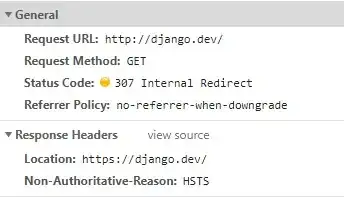The HSTS policy is cached by the browser for the seconds specified in the max-age directive (RFC 6797, 6.1.1). Removing the header from web server configuration doesn't remove the policy from the cache (nor a preloading list, if submitted to one), and therefore it continues causing 307 Internal Redirects on every browser that has already cached the policy.
As specified in RFC 6797, 5.3:
Only the given HSTS Host can update or can cause deletion of its
issued HSTS Policy. It accomplishes this by sending
Strict-Transport-Security HTTP response header fields to UAs with new
values for policy time duration and subdomain applicability. Thus,
UAs cache the "freshest" HSTS Policy information on behalf of an HSTS
Host. Specifying a zero time duration signals the UA to delete the
HSTS Policy (including any asserted includeSubDomains directive) for
that HSTS Host.
Therefore, the only way to remove an HSTS policy is to set an HSTS header with a zero duration, and the browser must also see this header on a secure connection without any TLS errors nor warnings (2.2).
<VirtualHost *:443>
. . .
Header always set Strict-Transport-Security "max-age=0"
</VirtualHost>
Strangely enough, everything works as expected if call the IP directly.
This is not strange at all. As explained in the Appendix A,
- HSTS Hosts are identified only via domain names -- explicit IP
address identification of all forms is excluded. This is for
simplification and also is in recognition of various issues with
using direct IP address identification in concert with PKI-based
security.
You can't disable HSTS on .dev
If this is literally a .dev domain, you can't disable HSTS.
Your security is our priority. The .dev top-level domain is included
on the HSTS preload list, making HTTPS required on all connections to
.dev websites and pages without needing individual HSTS registration
or configuration. Security is built in.
